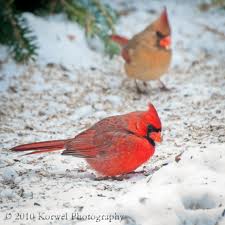
NORTHERN CARDINAL
(Richmondena cardinalis)
Of all the birds that visit our gardens and parks, none are more admired than the Northern Cardinal.
John James Audubon, the famous naturalist and artist wrote the Northern Cardinal “in richness of plumage, elegance of movement and strength of song, surpasses all its kindred in the United States.”
The spectacular male northern cardinal is instantly recognizable, being completely red with a black patch on his throat and a heavy red bill. The female cardinal has buff brown and tan feathers with a red wash across the chest, a black throat and a orange bill. Both male and females have a crest on top of their heads and are 71/2 to 9 inches long. Young cardinals resemble the females but with black beaks. As the males mature their feathers and beak begin to turn red.
The red coloration that males develop in their plumage is a result ofcarotenoids or pigments in their feather structure they ingest though their diet. There is a rare yellow cardinal. This is due to genetic plumage variation, but I have never seen one.
Cardinals are shy birds that prefer to stay close to cover. They are not normally aggressive but once it has established a mating territory in the spring, the male becomes very protective, especially against other male cardinals. Cardinals will attack their own reflections in puddles, windows and mirrors.
Once a male and female bond they stay together for life. Even in winter the pair is never far apart. Although cardinals mate for life, if one of the pair dies the other will quickly seek a new mate. In the wild the lifespan of a cardinal is usually three years. In captivity cardinals have been recorded to live fifteen years and one lived to be twenty-eight years old.
In early spring mating season begins. Nests are built by the female in dense shrubbery, thickets, small trees and briar tangles. The nests are loosely built of various materials such as animal hair, leaves, fine grasses, thin roots, tree bark, and small twigs. Males are not involved in nest building but remain close by to protect and feed his mate.
Once the nest is completed the female lays three or four greenish blue or greenish white eggs dotted with brown specks on them. Incubation of the eggs is done by the females while the male’s job is to supply food to her and their young. The eggs are incubated for 12 to 13 days before they hatch. When the first fledglings leave the nest the male continues to care for them while the female incubates the second clutch. The nestlings grow fast on a high protein diet of insects and seeds and are ready to leave the nest after ten days. Cardinals can have three clutches a year.
The male cardinals sing to attract a mate and mark his territory. The female sings when she is hungry or needs food for her young. The female sings a larger variety of tunes and songs than the male. If you are lucky you can hear them singing together. The males often sing two hundred times in an hour.
Cardinals commonly visit bird feeders in the early morning and at dusk, often being the last birds of the day. Cardinals also forage on the ground, scratching under shrubs searching for insects and seeds.
The cardinal’s strong beaks have evolved for cracking and eating seeds, a main source of their diets, but cardinals are omnivores. In addition to seeds cardinals eat insects, buds, berries and fruit. Cardinals also eat grains like oats, buckwheat, millet, sassafras and bread crumbs. Suet, a high-calorie fat, provides nutrients for cardinals when insects become scarce or non-existent in the winter.
Some cardinals have an unusual molting pattern which creates unpleasant naked-headed cardinals. Originally it was thought to be parasites were to blame, but some experts like Eastern Kentucky University ornithologist, Gary Ritchison believe this unusual feather loss may be a response to a traumatic injury.
Cardinals are non-migratory birds which means they don’t migrate in the winter months. Cardinals actually prefer to live within a mile of where they were born.
A southern bird, cardinals have slowly increased their range as far north as the Canadian border and east to the Dakotas.
Let me finish with a few interesting cardinal facts:
Cardinals are named after cardinals of the Roman Catholic church who wear bright red robes.
One of the most interesting facts about cardinals is that they practice what is appropriately called “anting”. In fact, over 200 species of birds, including the Baltimore Orioles and the wild turkey, also cover themselves with ants. It is possible that because the ants release formic acids, cardinals help themselves ward off lice.
The ants come from two subfamilies, they produce defensive secretions to repel attackers, and they don’t sting. The cardinal will hold an ant in its beak, spread and lower its wings, and bring its tail forward between its legs, wiping the outer wing and tail feathers with the ant.
The cardinal is seen as a symbol of some positive traits, and it is mainly portrayed as a reassuring sign. They symbolize confidence mainly because it is known for being a confident species.
Cardinals also represent balance as they serve as a powerful representation of a family. The father cardinal is in charge of nurturing young birds. Parent cardinals live a well-balanced family life, giving both of them the chance to take care of and nurture their offspring in turn.
The cardinal is the most popular state bird in the United States. These are the seven states in America that have the northern cardinal as their state bird:
Illinois (1929), Indiana (1933), Ohio (1933), Kentucky (1942), North Carolina (1943), West Virginia (March 7, 1949), Virginia (January 25, 1950).
There are many types of cardinals, a total of 19 subspecies which are mostly distinguishable by their colors.
Enjoy your garden all year long,
James
